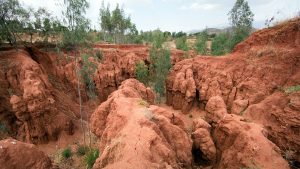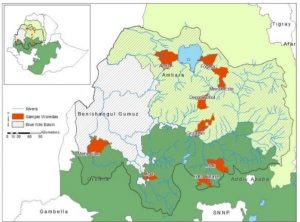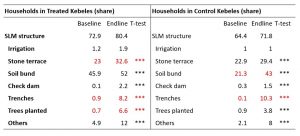Agriculture remains a cornerstone of the Ethiopian economy with 75 percent of the total population employed in the sector in 2012/13, and 86 percent living in rural areas. Current mixed crop-livestock land use practices, which often leaves farmland absent of groundcover and vulnerable to erosion during the rainy season, as well as widespread deforestation and seasonally heavy rainfall put Ethiopia’s agricultural areas at risk of serious land degradation which could lead to significant agricultural productivity declines. Recognizing this, the Ethiopian government and development partners continue to invest in sustainable land and watershed management programs across the highlands.
On February 20, 2017, IFPRI’s Emily Schmidt and Fanaye Tadesse presented the latest research on the impact of the Sustainable Land Management Program (SLMP). This study evaluates the impact of SLMP on the value of agricultural production in select woredas by using a panel survey from 2010 to 2014. Whereas previous studies have used cross-sectional data and short timeframe field trials to measure sustainable land management (SLM) effects on agricultural productivity, this analysis exploits data collected over four years to assess impact.
The government of Ethiopia has stressed the need to promote and invest in SLM, taking into account differences in agro-ecological conditions across Ethiopia (Growth and Transformation Plan). In collaboration with Ministry of Agriculture, World Bank, GIZ and other partners, the SLMP targets 937 kebeles in 209 woredas in 6 regions. During the presentation, Schmidt described the 4 components of the SLMP:
- Construct watershed and land management structures to stabilize soils
- Improve water retention and support efficient tillage practices
- Build capacity of service providers and rural households in implementation of SLM practices
- Enhance land tenure security of smallholder farmers
Photo 1 – Land degradation after heavy rainfall and runoff

Assessing the SLMP’s impact
Using panel data over a period from 2010 to 2014, the survey covered 1352 households in 7 woredas within the Blue Nile basin in Amhara and Oromiya regions.
Figure 1 – Map of sample sites
Source: Authors’ calculations
AA variety of parameters were used in the study to take into account differences between survey sites including agricultural land characteristics (land size, agricultural input use, etc), climatic conditions, experience of a weather shock (drought or flood) and a variety of household characteristics. Although the results of this research suggest that households within an SLMP program kebele did not experience significant increases in the value of total crop production compared to control households, the overall change in agricultural productivity across all survey sights suggests a promising trend. Total value of crop production increased in both treatment (by 25 percent) and control (21 percent) kebeles over the study period. In addition, a greater number of households reported SLM activities on their private land in 2013 compared to 2009.
Table 1 – SLM investments in control and treated kebeles (2009 and 2013)
Conclusion
In conclusion, Schmidt underlined the implications of these findings and the considerations for future investments in SLMP. Given the results, programs that incorporate a longer-term investment in the maintenance of SLM structures may have greater success of ensuring SLM uptake and sustainability among rural farmers.
Full details of this presentation and ESSP Working Paper 62 are available on ESSP’s website.
This presentation was organized by ESSP with support from EDRI. ESSP is a collaborative program undertaken by IFPRI and EDRI, whose objective is to help improve the policy-making decision process in Ethiopia.
Please subscribe to receive regular updates on ESSP’s work and its quarterly newsletter.

